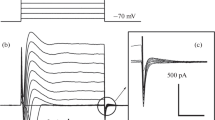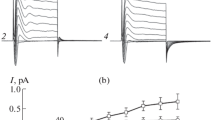Abstract
The electrodiffusive permeabiilty for Cl−, its dependence on low extracellular Cl−-concentrations and the interaction between the movements of Cl− and K+ were investigated in the ventricular membrane of epithelial cells from the choroid plexus ofNecturus maculosus. Cells were probed with ion-selective microelectrodes sensitive to Cl−, K+ and H+. The initial effects of abrupt changes in the Cl−-concentration (Cl −v ) and/or the K+-concentration (K +v ) of the ventricular solution were investigated. The effect of changing the membrane potential by changing K +v was twofold: It caused an electrodiffusive flux of Cl− via a permeability of 1.3 × 10−6 cm s−1. This permeability together with the K+-permeability of the ventricular membrane (24 × 10−6 cm s−1) determined the membrane potential in the given steady state within a few mV. The other effect of the depolarization was an increase in the intracellular concentration of HCO −13 which in turn caused an influx of Cl− via electroneutral Cl−/HCO −3 exchange. The Cl−-permeability was reduced by more than 60% and the neutral exchange by more than 90% by furosemide. The effect of decreases in Clv was a tenfold increase of the electrodiffusive Cl−-permeability of the ventricular membrane to 12.2 × 10−6 cm s−1 and also a tenfold increase in the permeability to K+. This activation was reduced by two thirds by furosemide, and by depolarizations of the cell by high Kv +. In the given steady state the HCO3 −/Cl− exchanger at the ventricular membrane transports at a rate of 300 pmol cm−2 s−1 and moves Cl− into the cell and HCO −3 into the ventricular solution. Thus the epithelium alkalinizes the cerebrospinal fluid at a rate which is about three times faster than the net transport rate of Na+.
Similar content being viewed by others
References
Bærentsen HJ, Giraldez F, Zeuthen T (1983) The influx mechanisms for Na+ and Cl− across the brush border membrane of leaky epithelia. A model and microelectrode study. J Membr Biol 75:205–218
Biagi B (1985) Effects of the anion transport inhibitor, SITS, on the proximal straight tubule of the rabbit perfused in vitro. J Membr Biol 88:25–31
Boron WF, Boulpaep EL (1983) Intracellular pH regulation in the renal proximal tubule of the salamander. Basolateral HCO −3 -transport. J Gen Physiol 81:53–94
Brazy PC, Gunn RB (1976) Furosemide inhibition of chloride transport in human red blood cells. J Gen Physiol 68:583–599
Christensen O, Zeuthen T (1986) Maxi K+-channels in leaky epithelia are regulated by intracellular Ca2+, pH and membrane potential. Pflügers Arch 408:249–259
Edelman A, Bouthier M, Anagnostopoulos T (1981) Chloride distribution in the proximal convoluted tubule of Necturus kidney. J Membr Biol 62:7–17
Frömter E (1984) Distribution of ion transport mechanism in epithelial cell membranes. In: Garlich DG, Korner PI (eds) Frontiers in physiological research. Austral Acad Sci, Canberra pp 51–61
Frohlich O, Leibson C, Gunn RB (1983) Chloride net efflux from intact erythrocytes under slippage conditions. Evidence for a positive charge on the anion binding/transport site. J Gen Physiol 81:127–152
Goldman DE (1943) Potential, impedance and rectification in membranes. J Gen Physiol 27:37–60
Hodgkin AL, Katz B (1949) The effect of sodium ions on electrical activity of the giant axon of the squid. J Physiol (Lond) 108:37–77
Johanson CE, Parandoosh Z, Smith QR (1985) Cl−HCO3 exchange i choroid plexus: Analysis by the DMO method for cell pH. Am J Physiol 249:F478-F484
Liedtke CM, Hopfer U (1982) Mechanism of Cl−-translocation across small intestinal brush-border membrane. I. Absence of Na+−Cl−-cotransport. Am J Physiol 242:G263-G271
Liedtke CM, Hopfer U (1982) Mechanism of Cl−-translocation across intestinal brush-border membrane. II. Demonstration of Cl−−OH− exchange and Cl−-conductance. Am J Physiol 242:G272-G280
Reuss L (1984) Independence of apical membrane Na+ and Cl− enty in Necturus gallbladder epithelium. J Gen Physiol 84:423–445
Reuss L, Constantin JN (1983) Cl−/HCO −3 exchange at the apical membrane of Necturus gallbladder. J Gen Physiol 83:801–818
Roos A, Boron WF (1981) Intracellular pH. Physiol Rev 61:296–434
Sarkadi B, Mack E, Rothstein A (1984a) Ionic events during the volume response of human peripheral blood lymphocytes to hypotonic media. I. Distinctions between volume-activated Cl− and K+ conduction pathways. J Gen Physiol 83:497–512
Sarkadi B, Mack E, Rothstein A (1984b) Ionic events during the volume response of human peripheral blood lymphocytes to hypotonic media. II. Volume-and time-dependent activation and inactivation of ion transport pathways. J Gen Physiol 83:513–527
Schou JC (1979) Effects of ATP on the intermediary steps of the reaction of the (Na++K+)-ATPase. Biochem Biophys Acta 567:421–435
Schou JC (1982) The effect of pH, of ATP and of modification with pyridoxal 5-phosphate on the conformational transition between the Na+-form and the K+-form of the (Na++K+)-ATPase. Biochem Biophys Acta 688:369–380
Wieth JO, Brahm J (1985) Cellular anion transport. In: Seldin DW, Giebisch G (eds) The kidney: Physiology and pathophysiology. Raven Press, New York, pp 49–89
Wright EM (1978) Transport processes in the formation of cerebrospinal fluid. Rev Physiol Biochem Pharmacol 83:1–34
Yoshitomi K, Burckhardt B-C, Frömter E (1985) Rheogenic sodium-bicarbonate cotransport in the peritubular cell membrane of rat renal proximal tubule. Pflügers Arch 405:360–366
Zeuthen T (1981) On the effects of amphotericin B and ouabain on the electrical potentials of Necturus gallbladder. J Membr Biol 60:167–169
Zeuthen T (1985) The advantages of transient experiment over steady state experiments. In: Kessler M, Harrison DK, Hoper J (eds) Ion measurements in physiology and medicine. Springer, Berlin Heidelberg New York, pp 150–157
Zeuthen T, Christensen O (1986) Exit mechanisms for K+ and Cl− in leaky epithelia. Renal Physiol Basel 9:91
Zeuthen T, Wright EM (1981) Epithelial potassium transport: Tracer and electrophysiological studies in choroid plexus. J Membr Biol 60:105–128
Zeuthen T, Christensen O, Bærentsen JH, la Cour M (1986) The mechanism of electrodiffusive K+-transport in leaky epithelia and some of its consequences for anion transport. Pflügers Arch 408:260–266
Zeuthen T, Christensen O, Cherksey B (1986) Electrodiffusion of Cl− and K+ in epithelial membranes reconstituted into planar lipid bilayers. Pflügers Arch 408:275–281
Author information
Authors and Affiliations
Rights and permissions
About this article
Cite this article
Zeuthen, T. The effects of chloride ions on electrodiffusion in the membrane of a leaky epithelium. Pflugers Arch. 408, 267–274 (1987). https://doi.org/10.1007/BF02181469
Received:
Accepted:
Issue Date:
DOI: https://doi.org/10.1007/BF02181469




